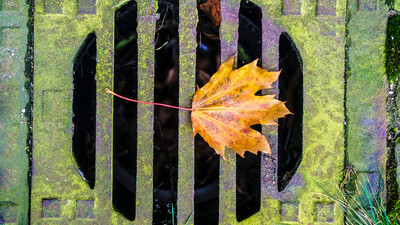A drainage system gully features a top opening that allows storm or wastewater to run from roads, pavements and other large impervious areas into the drainage system. Floor gullies also feature internally, for example in processing areas where equipment washdown is carried out and in food processing plants. An outlet on one or more sides of the gully chamber connects the gully to the rest of the drainage system.
The most common example of a drainage gully is the type installed adjacent to the kerb on asphalt roads; these are very simply designed with the outlets opening directly into the gully chamber, but where a drain system is used for sewage or wastewater, or if the gully is located inside a building, a trapped gully must be used to prevent gases or foul odours from the drain escaping.
While gully traps may vary in design, they all use the same principle that anyone familiar with the trap under a domestic sink will understand. As with domestic sink wastes, there are two main types of gully trap: the ‘P’ trap and the bottle trap. Below, we will explore the various different types of gully trap, explaining what they look like, and what they are best used for.
The P Trap
Studied from the side, a P trap resembles the letter P rotated clockwise by ninety degrees. Water passing from the hopper at the top of the gully enters at the top-right corner, falls to the base of the trap – the gully pot – and rises to the height of the outlet base. This creates an airtight seal between the gully hopper and the outlet, which prevents gases and foul air from escaping. As more water enters the gully it passes through to the outlet, so that the water in the hopper remains level with the outlet base.
The S Trap
The S trap is similar to the P trap in that it is comprised of a single uninterrupted length of pipe. The first stretch of pipe falls vertically to a 180-degree bend, rises sufficiently to create an airlock and then performs a second 180-degree turn to continue its downward trajectory. This design is the one most commonly used in internal floor gullies.
The Bell Trap
The bell trap was once widely used for floor drains. The main chamber set into the floor features an exit pipe that rises vertically from the centre of the chamber and a deep, circular flange attached to the underside of the trap’s perforated floorplate cover. The gaps between the inner diameter of the flange and the outer diameter of the exit pipe, and the top of the exit pipe and the bottom of the trap cover, allow the water to flow through the trap. The rim of the flange is set lower than the top of the exit pipe to create an airlock.
On earlier designs, a hemispherical cone shape resembling a bell was used in place of the later flange design, and this is what gave the bell trap its name.
The Bottle Trap
A bottle trap gully features two cylindrical chambers. Water entering the gully hopper passes into the inner chamber, which has an open base that allows the water to flow out into the outer chamber. The outlet from the outer chamber is positioned higher than the base of the inner chamber so once again, residual water in the trap creates an airtight seal between the hopper and the outlet.
Trapped Gully Housekeeping
Under normal circumstances, a trapped gully is very effective, and with no moving or wearing parts, it also requires little to no maintenance. But problems can still occur with gully traps; therefore, it is important to know how these can be avoided.
A trapped gully that is seldom used may result in the water in the trap stagnating or evaporating. If evaporation takes the water level lower than the curve of a P trap or the inner chamber base of a bottle trap, gases and foul odours from the drain will be able to escape. If a trapped gully isn’t regularly used, this can be avoided by occasionally topping it up with water. Adding some form of disinfectant to the water can also prevent bad smells from stagnation.
Even storm and wastewater often contain particles that are heavier than water and will tend to accumulate as silt in the trapped gully. Where this is a known problem, regular checking and cleaning will ensure the gully works at full efficiency. Of the two designs, the bottle trap gully is by far the easiest to check and clean, as the inner chamber is removable. This opens up the entire sump area at the base of the gully and in the event of a blocked outlet or connection to the main system, enables easy access with drain rods.
If you would like to know more about specifying, installing or designing a drain system with trapped gullies, contact UK drainage system experts Drainfast on 01730 774000 or email them at [email protected]. You can also view our full range of gully traps here.

